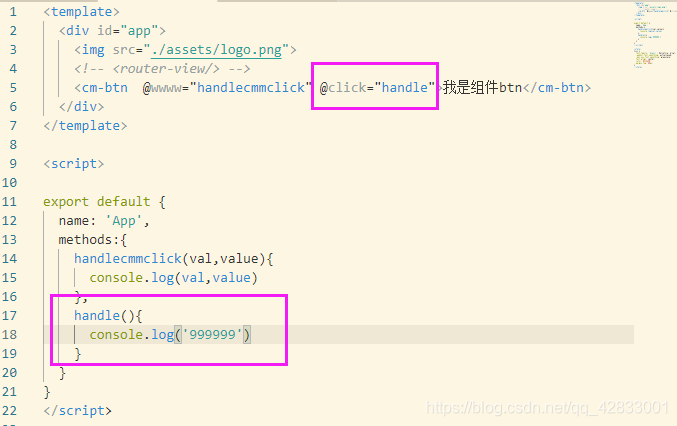无论是在哪个项目中,都会将常用的功能单一的组件进行封装,便于之后的使用的快捷
这里以button的封装为例,理解组件间的父子通信
子组件button
<template>
<button
:disabled="disabled"
@click.prevent="handleClick"
>
<slot></slot><!--slot 用于显示使用此组件的时候,中间写入的文字-->
</button>
</template>
<script>
export default {
name:'cm-btn',
// 任何想要拿到从父组件传递过来的数据,都需要用props进行接收,不然获取不到
props:{
disabled:'',
href:'',
},
methods:{
handleClick(){
//在子组件的内部,子组件获取到的从父组件的数据,使用的时候直接用this.XXX进行使用
if(this.href){
this.$router.push(this.href)
}
//this.$emit("function",param); function是父组件进行实际绑定的时候@后面的名字,
//param是触发父组件的事件后,传递给父组件的数据,在父组件中,通过参数进行接收
this.$emit('wwww','555555')//返回的param有多个的时候,用,隔开
//this.$emit('wwww','555555','787897')
}
},
}
</script>
<style lang="scss" scoped></style>
父组件
<template>
<div id="app">
<img src="./assets/logo.png">
<!-- <router-view/> -->
<cm-btn @wwww="handlecmmclick">我是组件btn</cm-btn><!-- 此时已经全局注册过此组件,所以可以直接使用 -->
</div>
</template>
<script>
export default {
name: 'App',
methods:{
handlecmmclick(val){
//通过参数,接收子组件触发事件后,传递回来的数据
console.log(val)
}
// handlecmmclick(val,value){
// console.log(val,value)
// }
}
}
</script>
<style></style>
在使用子组件的时候,如果想要绑定在子组件的方法生效,那么一定要使用触发父组件事件的方式。如果没有使用这种方式,在父组件本身的方法里面去书写这个方法的处理,是不会有用的

上图中的999999的打印并不会有。

在子组件的本身也是需要绑定一个事件去触发父组件的事件








 本文以button组件封装为例,深入解析Vue.js中子组件与父组件的通信机制,演示了如何通过props传递数据及使用$emit触发父组件事件。
本文以button组件封装为例,深入解析Vue.js中子组件与父组件的通信机制,演示了如何通过props传递数据及使用$emit触发父组件事件。
















 1058
1058

 被折叠的 条评论
为什么被折叠?
被折叠的 条评论
为什么被折叠?








